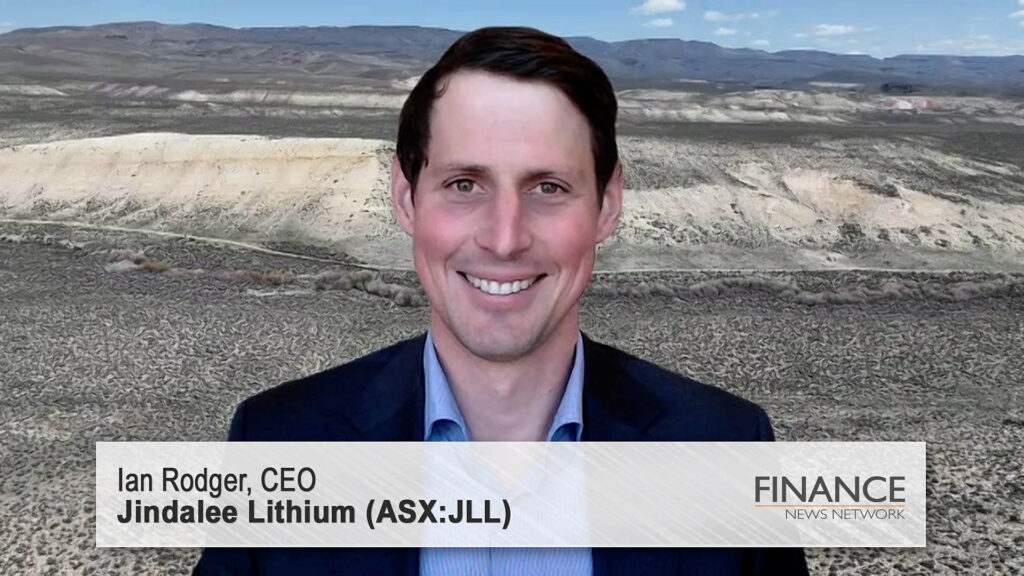Jindalee Lithium Limited (ASX:JLL) CEO Ian Rodger provides an overview of the company, discussing the McDermitt project, progress on the PFS and grant funding.
Peter Milios: I’m Peter Milios from the Finance News Network, and today we’re talking with Jindalee Lithium (ASX:JLL). Jindalee is trading under the ASX code “JLL” and has a market capitalisation of approximately $20m. Jindalee, or JLL, is at the forefront of realising America’s largest lithium resource. Today, we’re pleased to have with us Jindalee’s CEO, Mr Ian Rodger. Ian, welcome to the network.
Ian Rodger: Thanks for having me, Peter.
Peter Milios: To kick off, can you just give us an overview of your business?
Ian Rodger: Jindalee’s flagship project is the McDermitt Lithium Project. It’s located in the McDermitt caldera, on the border of Oregon in Nevada in the US. As you sort of touched on in your opening remarks there, it’s the largest lithium resource in the US, and it’s a significant deposit globally at 21.5 million tonnes of lithium carbonate equivalent. We commenced a prefeasibility study in the middle of last year with Fluor as the lead engineer, and we’re now in the meaty part of that work. We announced some test results producing lithium carbonate, so we’ve really validated our process flowsheet, and our PFS is due out later in the year. But from a big picture, Jindalee has the potential to really play a meaningful role in the build-out of the US EV supply chains. We’re going to produce a battery-grade chemical, and that can really feed into those supply chains and decouple their reliance on China.
Peter Milios: You just mentioned that your battery-grade lithium carbonate has been produced from McDermitt, but can you give us a bit more detail about this?
Ian Rodger: If you take a step back, it’s a lithium sedimentary deposit. The lithium is actually associated with the clay minerals. It’s a very shallow orebody, very soft. And so, really, the process is dig it up. It’s very, like I said, soft. The strip ratio’s about one, very cheap mining. Then the process flowsheet is that the ore then gets beneficiated, which is essentially washing out the coarse material and keeping the fine fragment, and then that’s an upgraded feed into a leach circuit, where lithium is brought in the solution and then, through a number of different steps, purified into a lithium chemical. And that’s important, the lithium chemical part. It’s a battery-grade lithium carbonate that can go straight into cathode plants and then in gigafactories. The comparison to say, the spodumene, which Australian investors are much more familiar with, their model is dig it up. Normally it’s a much higher strip ratio, it’s harder rock, it’s higher cost to get out of the ground. Then there’s a concentration step. And then the backend of the spodumene route, it’s a much more complicated process. It’s, you know, calcination at 1000 degrees, fine grinding, and then to produce a lithium chemical. And that is normally done in China. They’re building two in Australia at the moment. They’re building one in the US. But largely all these spodumene producers send their stuff to China to do that real chemical processing. And that’s what I was saying before around why this project’s so strategic, and as is our near-neighbours in Lithium Americas, who are a bit more advanced than us and in construction, they’re going to produce, like us, a lithium chemical or lithium carbonate, a battery-grade lithium carbonate that can go directly into Stateside batteries as opposed to this China story.
Peter Milios: So, Ian, you’ve obviously recently completed the capital raising. You’re also supported by the Biden Administration Act. How is funding, and what will these funds be used for?
Ian Rodger: We’ve currently got two grant applications in, one with the Department of Defense and one with the Department of Energy, both of which would materially co-fund different aspects of the project. The one that we’re probably most excited about is the one with the Department of Defense. It would materially co-fund a feasibility study. So, you know, from the PFS through to a FID decision. And that’s free money, I guess. It’s not a loan or what not, it’s non-recourse grant funding that we would have to match in the order of 50 per cent. So, there’s no certainty around either of these. The Department of Energy one is for a larger amount, but potentially to help on demonstration scale test work, or go towards the capex of the project eventually. We’re hoping in the second half of this year that we get a notification decision around those, and we’re pretty excited by that. On the government support side of things, we’ve also flagged in some of our guidance we’re in advanced negotiations with a technical cooperation agreement with some US government agencies. And that’s probably earlier on the horizon than the grant funding, but it also sort of speaks to that we’re pretty tapped into these different agencies, and we hope to convert some of this into material support in the not-too-distant future.
Peter Milios: Ian, you mentioned the PFS, can you provide an update on where that is at?
Ian Rodger: For sure. We’re well-advanced on the PFS. We’re just finalising our mine plans at the moment. What we expect that the PFS will show is large-scale production of lithium chemicals over multi-decades. And so that’s why I say it’s a strategic asset, and that’s why it’s material production. Unlike a lot of our peers in spodumene and others that have mine lives of 10 to 15 years, it’ll be orders of magnitude larger than that. We’re really excited about pulling this together in the next couple of months and sharing it with the market.
Peter Milios: Ian, thank you.
Ian Rodger: Awesome. Thank you.
Ends

